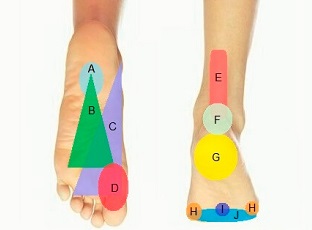- Home
- Foot & Ankle Exercises
- Heel Exercises
Exercises For Heel Pain
Written By: Chloe Wilson BSc(Hons) Physiotherapy
Reviewed By: FPE Medical Review Board

Exercises for heel pain are one of the fastest and most effective ways to get back on your feet.
Whether your heel throbs first thing in the morning, flares up after standing all day, or aches after a long walk, the right heel pain exercises can make a huge difference.
Heel pain is incredibly common and often caused by tight, overworked, or irritated tissues such as the plantar fascia or Achilles tendon. When these structures stiffen up, every step pulls on your heel, leading to that sharp, nagging pain that just won’t go away.
The good news? You don’t need expensive treatments or weeks off your feet. Simple, targeted heel pain relief exercises, done consistently, can loosen tight muscles, reduce inflammation, and build strength and flexibility where you need it most.
In this guide, you will find the best exercises for pain in the heel, from easy home stretches to strengthening moves that support lasting recovery. These heel pain treatment exercises are quick to do, require no equipment, and can help you move, walk, and run without pain again.
What Causes Heel Pain?
Heel pain usually develops when the soft tissues that support your heel become irritated, overstressed, or inflamed. Understanding the cause is key to choosing the right exercises for heel pain.
The most common culprits of heel pain are:
1. Plantar Fasciitis
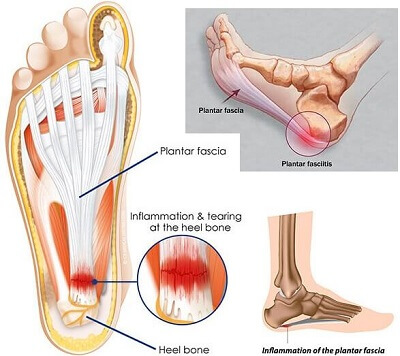
Plantar fasciitis is the most frequent cause of heel pain.
The plantar fascia, a thick band of tissue under your foot, becomes tight and irritated where it attaches to the heel bone.
- Plantar fasciitis pain is typically worst with the first few steps in the morning.
- It eases as you move but returns after standing or walking for long periods.
- Stretching and strengthening exercises are the cornerstone of plantar fasciitis treatment.
2. Achilles Tendinitis
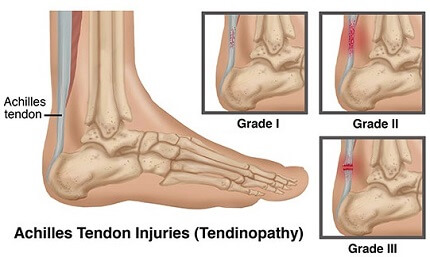
The Achilles tendon connects your calf muscles to the back of your heel bone.
Overuse, poor footwear, or tight calves can cause irritation or micro-tears near the heel, resulting in achilles tendonitis.
- Achilles tendonitis pain often feels worse at the back of the heel, especially after activity.
- Eccentric heel exercises (controlled lowering movements) help rebuild strength and resilience.
3. Heel Bursitis
Small fluid-filled sacs (bursae) cushion the heel. These can become inflamed from repetitive pressure or ill-fitting shoes, resulting in heel bursitis.
- Heel bursitis pain is felt deep behind or underneath the heel
- Gentle heel stretching exercises and activity modifications help calm inflammation
4. Heel Fat Pad Syndrome
The natural fat pad under your heel acts as a shock absorber. Over time, it can thin or shift, reducing cushioning.
Heel fat pad pain feels like a deep bruise in the centre of the heel.
Supportive footwear and strengthening of the foot muscles can help.
5. Nerve Entrapment or Stress Fracture
Less common, but worth mentioning — irritation of nerves around the heel or small stress fractures can also cause pain. If your heel pain is severe, persistent, or accompanied by swelling or numbness, it’s best to get it checked by a healthcare professional.
Why Do Heel Pain Exercises Help?
Targeted exercises for heel pain reduce pain and stiffness by:
- Improving flexibility of the plantar fascia and calf muscles
- Enhancing blood flow to the heel area and promoting healing
- Strengthening the foot and lower leg muscles that support the heel
- Correcting poor foot mechanics to reduce strain
Consistency is crucial with exercises for pain in the heel. Just 10 minutes per day of focused heel pain relief exercises can significantly reduce pain and improve mobility.
Best Stretching Exercises For Heel Pain
Let’s start by looking at the best stretching exercises for heel pain, which help to improve the flexibility, mobility and length of the calf muscles and the muscles underneath the foot.
1. Foot Arch Stretch
Stretching exercises for heel pain start by targeting the muscles and fascia that attach of the bottom of the heel.
Best for: Plantar fascia tightness and post-rest stiffness
How to do it:
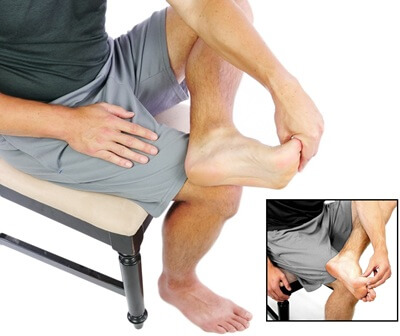
- Sit in a chair and place the foot to be stretched on top of
your other knee
- Grab all your toes and bend them back into extension as
shown, until you feel a stretch under your arch
- Hold for 10-15 seconds and relax. Repeat 5-10 times
- Then, from the same starting position, grab just your big
toe and bend it backwards
- Again, hold for 10-15 seconds and repeat 5-10 times.
Tip: Massage your plantar fascia with your thumb during the stretch to improve circulation.
2. Rolling Stretches
This is a great heel pain exercise to do while you are sitting down relaxing
Best for: Plantar fasciitis and morning stiffness
How to do it:

- While seated, place a small firm ball underneath the arch of your foot.
- Press your foot down into the ball and roll it forwards and backwards and round in circles.
- Keep pressing down through the ball throughout.
- Spend 2-3 minutes doing this, twice a day, especially before and after activity
Progression: do this exercise standing up so you can put more pressure through the ball
Tip: Freeze a drinks can and use that underneath your foot instead of the ball. The cold helps to reduce inflammation and reduce pain as well as stretching the foot
3. Standing Calf Stretches
The calf muscles attach to the back of the heel making calf stretches really important exercises for heel pain
Best for: Tight calves, Achilles tendinitis, and plantar fasciitis
How to do it:
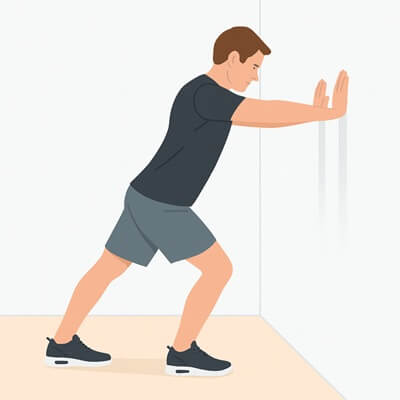
- Stand in front of a wall, with your hands resting on the
wall.
- Step back with the leg to be stretched, making sure your
toes are pointing forwards, not out to the side.
- Lunge forwards onto your front leg, allowing the front knee
to bend until you feel a stretch in the back of your calf.
- Keep your back leg straight, and your heel on the floor
- Hold for 30 seconds and repeat 3 times
Progression: place a rolled up towel underneath your toes to increase the stretch through the foot and calf
Best Strengthening Exercises For Heel Pain
As well as stretching the muscles that attach to the heel, it is also important to do strengthening exercises for heel pain to reduce the strain through the heel and improve stability and support.
1. Heel Raises
This is a great place to start with heel pain relief exercises. There are lots of different variations of heel raises so that you can work progressively harder as you build up strength.
Best for: Achilles tendon and calf strength and plantar fascia support
How to do it:
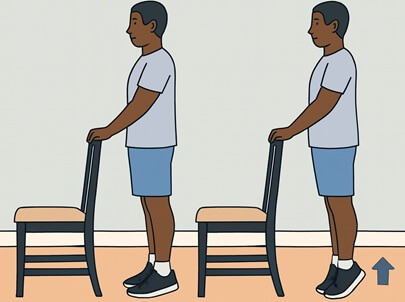
- Stand holding onto the back of a chair or a table for balance
- Slowly lift your heels up of the floor and rise up onto your tip toes as high as you can.
- Hold for 3-5 seconds and slowly lower down
Progressions: 1. Stand on just one leg while doing the exercise
2. Start by squatting down slightly and then lifting your heels up – great for working on your balance
3. Stand on a step, letting your heels hang off the bottom of the step. Drop the heels right down and the lift them up as high as you can, pushing up onto tip toes.
4. Repeat the last exercise but standing on one leg on the step

Tip: Ensure slow, controlled movements to avoid strain and work the muscles harder
2. Towel Scrunches
This is a great way to strengthen the muscles underneath the foot that support the heel
Best for: weakness in the foot
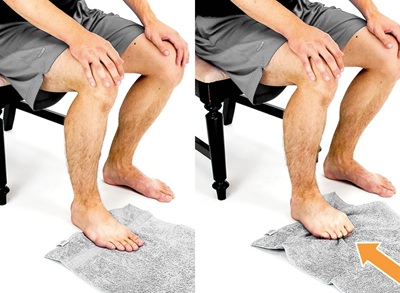
How to do it:
- Sit in a chair with a towel underneath your foot.
- Curl your toes to scrunch the towel, as if you are trying to pick it up off the floor
- Relax and repeat for 2-3 minutes
Tip: another variation of this is to try picking up marbles from the floor with your toes
3. Tip Toe & Heel Walking
Walking on your tip toes or heels is a great way to strengthen and stretch the foot and calf muscles, improve ankle stability and balance and improve proprioception, making this a great exercise for heel pain.
Best for: weakness and stability issues
How to do it:
- Standing upright, rise up onto your tip toes on both feet
- Keeping your heels up off the ground, take a few steps forwards and then backwards
- Spend about 1-2 minutes doing tip toe walking
- Then lift your toes up off the ground so you are balancing on your heels, and again, walk forwards for a few steps and then backwards, keeping your toes up the whole time.
- Spend about 1-2 minutes doing heel walking
Progression: You can challenge your balance further by doing these exercises with your eyes closed
4. Single Knee Dips
Exercises for heel pain should also focus on strength and control around the hip and knee. Single knee dips helps to not only stretch and strengthen the heel area, but also improve knee and foot position and stability.
Best for: all causes of heel pain
How to do it:

- Stand on one leg holding onto a table or chair for balance.
- Slowly let the knee bend around 30 degrees, lowering your body towards the floor.
- Make sure not to keep your weight backwards - don’t let your knee come forwards or drop inwards.
- Hold for 3-5 seconds and slowly come back up
Progression: do this heel pain exercise without holding on to anything for support to work harder
Morning Heel Pain
Routine
Heel pain is often worse in the morning because tissues tighten overnight. A quick routine before getting out of bed can reduce stiffness:
- Foot Arch Stretch: 5-10 reps per foot
- Roller Stretches: 2 minutes per foot
- Standing Calf Stretch: 3 reps per foot
Doing these exercises for heel pain takes less than 5 minutes and can significantly reduce morning pain and stiffness so you get going quicker. Do the other heel pain relief exercises once you are up and about.
Tips for Success
To get the best results from your heel pain exercises:
- Stretch in the morning and after periods of sitting to ease stiffness
- Perform strengthening exercises once or twice daily as pain allows
- Avoid sharp pain; move slowly and do not bounce during stretches
- Be consistent and do your heel pain treatment exercises daily (preferably twice daily) for best results.
- Stretch after activity to help your muscles recover and stay flexible.
If your heel pain hasn’t improved after 2–3 weeks of consistent exercise, consult your physical therapist or doctor.
What Else Can Help Heel Pain?
While exercises are one of the most effective ways to treat heel pain, a few other strategies can speed up recovery and prevent the pain from coming back.
- Supportive Footwear: Choose shoes with good arch support and cushioning under the heel. Avoid worn-out trainers or flimsy flats that offer little shock absorption.
- Orthotic Insoles: Over-the-counter or custom orthotics can help correct foot alignment issues like over-pronation or high arches, reducing strain on the plantar fascia and Achilles tendon.
- Rest & Ice: Resting your feet after activity and applying an ice pack for 10–15 minutes can calm inflammation and ease soreness, especially at the end of the day.
- Night Splints: Wearing a night splint keeps your foot gently stretched overnight, preventing morning stiffness and pain.
- Massage & Foam Rolling: Gentle massage of the calves, foot arches, and soles helps improve blood flow and release tight fascia.
- Gradual Return to Activity: If your heel pain started after a sudden increase in walking or running, ease back in gradually. Mix in low-impact exercises like cycling or swimming until symptoms settle.
Combining these approaches with regular heel pain relief exercises is the best way to achieve long-term comfort and avoid recurring problems.
FAQs About Heel Pain
Exercises
Let's have a look at some of the most frequently asked questions around exercises for heel pain.
1. How Often Should I Do Heel Pain Exercises?
1. How Often Should I Do Heel Pain Exercises?
Stretching exercises for heel pain 2–3 times a day and strengthening exercises once or twice daily is ideal. Consistency matters more than intensity with exercises for pain in heel.
2. How Long Before I Feel Relief?
2. How Long Before I Feel Relief?
Most people notice improvement within 2–3 weeks if heel pain treatment exercises are done regularly, though full recovery from plantar fasciitis or Achilles tendonitis may take a few months.
3. Should I Exercise If My Heel Still Hurts?
3. Should I Exercise If My Heel Still Hurts?
Gentle stretching is fine, but avoid intense or high-impact activity until pain improves. If your heel pain worsens, stop and rest.
4. Do I Need Special
Equipment?
4. Do I Need Special Equipment?
No — a towel, wall, and a small ball or water bottle are all you need for most heel stretching exercises.
5. When Should I See A
Doctor?
5. When Should I See A Doctor?
If heel pain persists for more than a few weeks of doing these exercises for heel pain, or if it is severe, swollen, or affects walking, it is best to get a professional assessment to rule out a stress fracture or nerve issue.
Exercises For Heel Pain Summary
Heel pain exercises are one of the simplest and most effective treatments for foot discomfort. They can help relief both heel pain and foot arch pain.
Regular heel stretching and strengthening exercises, such as towel stretches, heel raises, and plantar fascia massage, help loosen tight tissues, improve flexibility, and reduce inflammation.
- Stretch and strengthen the plantar fascia, calves and foot muscles at least twice a day
- Use supportive footwear and orthotics if needed
- Avoid high-impact activity during flare-ups
- Start slow with heel pain treatment exercises, progress gradually, and avoid sharp pain
- Combine exercises with rest, ice, and massage for faster relief
In short: gentle, consistent strengthening and stretching exercises for heel pain are the key to lasting comfort and healthy, pain-free feet.
Related Articles
References
- Effects of Strengthening
and Stretching Exercises on the Temporospatial Gait Parameters in Patients With
Plantar Fasciitis: A Randomized Controlled Trial. Annals Of Rehabilitation Medicine
- Management Of Plantar
Heel Pain: A Best Practice Guide Informed By A Systematic Review, Expert
Clinical Reasoning And Patient Values. British Journal Of Sports Medicine
- Development Of A Foot
And Ankle Strengthening Program For The Treatment Of Plantar Heel Pain: A Delphi
Consensus Study. Journal Of Foot & Ankle Research
- Heel Pain. NHS UK
Page Last Updated: 7th November, 2025
Next Review Due: 7th November, 2027

